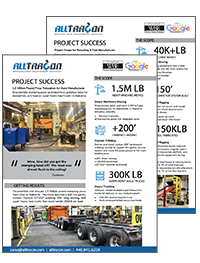Anchor Machines: The Backbone of Secure Foundations
In the world of construction and infrastructure development, the strength and stability of foundations are paramount. Whether it’s a towering skyscraper, a massive bridge spanning a river, or a sturdy highway overpass, the integrity of these structures hinges on the reliability of their foundations. One crucial element in creating these secure foundations is the use of anchor machines. These machines play a vital role in installing various types of anchors that provide stability, prevent movement, and ensure the long-term safety of structures. In this comprehensive guide, we delve into the world of anchor machines, exploring their types, functions, applications, and the pivotal role they play in creating the backbone of secure foundations.
Understanding Anchor Machines
What are Anchor Machines?
These machines are specialized construction equipment designed to install a variety of anchors into the ground. These anchors serve as connectors between the foundation of a structure and the soil or rock beneath it. By securely fastening the structure to the ground, anchor machines ensure stability and prevent movement caused by external forces such as wind, seismic activity, or soil erosion.
Types of Anchor Machines
- Hydraulic Anchor Machines: These machines utilize hydraulic power to drive anchors into the ground. They are capable of exerting immense force, making them suitable for installing anchors in hard soil or rocky terrain.
- Pneumatic Anchor Machines: Pneumatic anchor machines rely on compressed air to drive anchors into the ground. They are often more portable and lightweight compared to hydraulic machines, making them versatile for various construction sites.
- Drill Rigs with Anchor Installation Capabilities: Some drill rigs are equipped with attachments or capabilities for installing anchors. These rigs can drill holes and simultaneously install anchors, streamlining the process and increasing efficiency.
The Functions of Anchor Machines
Anchoring for Stability
The primary function of these machines is to provide stability to structures. By firmly anchoring the foundation to the ground, these machines prevent movement or shifting, especially in areas prone to soil instability or seismic activity.
Load Distribution
Anchor machines also play a crucial role in distributing the load of a structure evenly across the foundation. This helps in reducing the risk of settlement or uneven stress on the structure, ensuring its longevity and safety.
Preventing Uplift Forces
In areas with high wind speeds or where structures are susceptible to uplift forces, anchor machines are used to counteract these forces. By installing anchors deep into the ground, they provide resistance against uplift, keeping the structure firmly in place.
Applications of Anchor Machines
Skyscraper Construction
When it comes to constructing skyscrapers, anchor machines are indispensable. These towering structures require deep, sturdy foundations to support their weight and withstand forces such as wind and seismic activity. These machines are used to install massive anchors deep into the ground, ensuring the stability and safety of these iconic buildings.
Bridge and Viaduct Construction
Bridges and viaducts span vast distances, often over water bodies or challenging terrain. These machines are used to secure the bridge abutments and piers to the ground, preventing any shifting or movement that could compromise the structure’s integrity. Additionally, they help distribute the weight of the bridge evenly, ensuring its long-term durability.
Retaining Walls and Slope Stabilization
In areas with steep slopes or where erosion is a concern, anchor machines are used to create retaining walls and stabilize slopes. By installing anchors into the soil, these machines prevent landslides, soil erosion, and the collapse of retaining walls, safeguarding infrastructure and surrounding areas.
Advancements in Anchor Machine Technology
Automated Anchor Installation
Modern anchor machines are equipped with advanced automation technology, allowing for precise and efficient anchor installation. These machines can accurately drive anchors to specific depths and angles, reducing human error and improving the overall quality of the foundation.
Remote Monitoring and Control
Some these machines come with remote monitoring and control capabilities, enabling operators to monitor the installation process from a distance. This not only enhances safety by reducing on-site personnel but also allows for real-time adjustments and troubleshooting.
Eco-Friendly Anchoring Solutions
With a growing focus on sustainability, manufacturers are developing eco-friendly anchoring solutions. This includes biodegradable anchors, recyclable materials, and energy-efficient machines that minimize the environmental impact of installation.
Conclusion
Anchor machines are the unsung heroes of construction, providing the essential support and stability needed for secure foundations. From skyscrapers reaching for the sky to bridges spanning vast distances, these machines play a pivotal role in ensuring the safety and longevity of our infrastructure. Understanding the types, functions, applications, and advancements in anchor machine technology is key to appreciating their importance in the world of construction. As technology continues to evolve, we can expect these machines to become even more efficient, precise, and environmentally friendly, further solidifying their status as the backbone of secure foundations.

